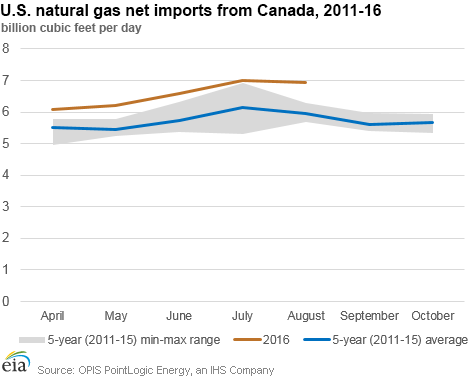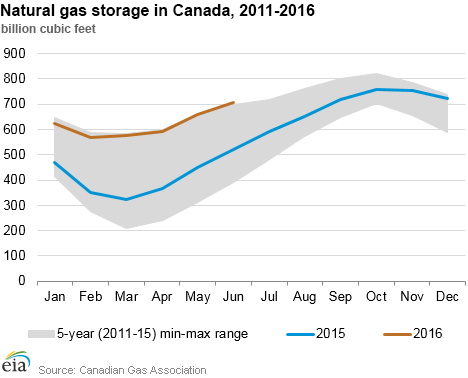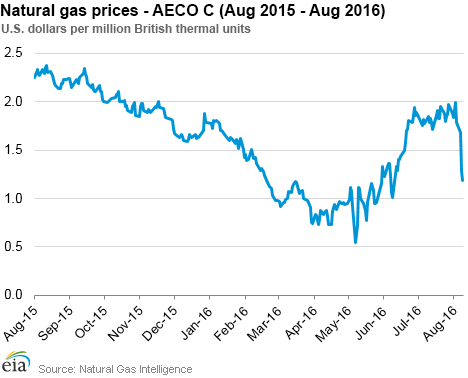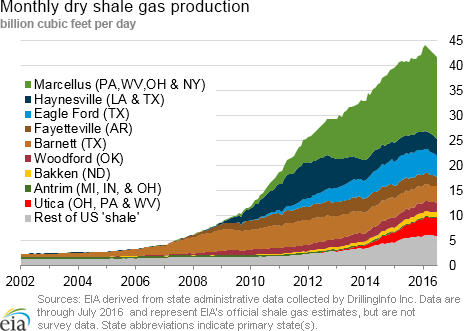In the News:
U.S. natural gas imports from Canada increase with low AECO prices
U.S. natural gas net imports from Canada rose to about 7 billion cubic feet per day (Bcf/d) yesterday, and are estimated to climb to 7.8 Bcf/d today, according to data from PointLogic, as hot weather spans much of the United States. These relatively high levels of imports from Canada follow a near-record summertime level reached near the end of July, when U.S. natural gas net imports from Canada exceeded 8 Bcf/d. The five-year (2011-15) average for U.S. natural gas net imports from Canada over the June through August 10 period is 6.8 Bcf/d. Usually, imports from Canada are highest during the winter heating season, peaking in January at around 9.5 Bcf/d.
The increased demand for imports from Canada comes at a time of seasonal highs in Canadian stocks. In addition, Canadian gas prices are relatively low compared to the Henry Hub in Louisiana. Natural gas storage in Canada exceeded the five-year (2011-15) maximum in June and have remained at seasonally high levels since. Inventories averaged 621 billion cubic feet (Bcf) over the first half of 2016, a 50% increase over the same period for the previous year.
The increase in storage also follows a first-quarter production increase in Canada that surpassed five-year highs by 2.7%. Production in 2015 was also at or near the same five-year (2011-15) maximums, according to recent data from Canada's National Energy Board. Storage levels were boosted by reduced consumption in Canada, which over the first quarter of 2016 averaged 1 Bcf/d lower than in the first quarter of 2015, a decrease of 9.5%. Declines in consumption likely continued into the second quarter because of the loss of natural gas used in oil sands production because of May wildfires in Alberta.
The spot price of natural gas at Western Canada's AECO C price point reached a five-year year low of U.S. 55¢ per million British thermal units (MMBtu) in May. Since then, the price has increased, as has the Henry Hub spot price, to just under $2/MMBtu for much of the summer, and has been lower than the Henry Hub by about $1/MMBtu, a differential that has widened from around 50¢/MMBtu in 2015. The AECO C is a virtual trading point that generally includes all trades on TransCanada's Alberta pipeline system. Over the past week, prices have declined by 80¢/MMBtu, and the differential to Henry Hub increased to $1.54/MMBtu yesterday, which likely supported the increased U.S. demand for Canadian natural gas.
Overview:
(For the Week Ending Wednesday, August 10, 2016)
- Natural gas spot prices fell at most locations outside of the Northeast this report week (Wednesday, August 3, to Wednesday, August 10). The Henry Hub spot price fell from $2.88 per million British thermal units (MMBtu) last Wednesday to $2.73/MMBtu yesterday.
- At the New York Mercantile Exchange (Nymex), the September 2016 contract fell 28¢, from $2.839/MMBtu last Wednesday to $2.561/MMBtu yesterday.
- Net injections to working gas totaled 29 Bcf for the week ending August 5. Working gas stocks are 3,317 Bcf, which is 12% greater than the year-ago level and 15% greater than the five-year (2011-15) average for this week.
- According to Baker Hughes, for the week ending Friday, August 5, the natural gas rig count decreased by 5 to 81. This is the lowest natural gas rig count in the Baker Hughes dataset, which goes back to 1987. The number of oil-directed rigs rose by 7 to 381. The total rig count climbed by 1, and now stands at 464.
- The natural gas plant liquids composite price at Mont Belvieu, Texas, fell by 14¢, closing at $4.56/MMBtu for the week ending August 5. The price of ethane and propane fell by 9% and 5%, respectively; the price of natural gasoline and isobutane each rose by 2%; and the price of butane remained flat week over week.
Prices/Supply/Demand:
Spot prices mostly down. This report week (Wednesday, August 3, to Wednesday, August 10), the Henry Hub spot price fell 15¢ from $2.88/MMBtu last Wednesday to $2.73/MMBtu yesterday. At the Chicago Citygate, prices decreased 16¢ from $2.85/MMBtu last Wednesday to $2.69/MMBtu yesterday. Prices at PG&E Citygate in California lost 6¢, going from $3.18/MMBtu last Wednesday to $3.12/MMBtu yesterday.
Northeast market prices rise. At the Algonquin Citygate, which serves Boston-area consumers, prices went up 82¢ from $2.93/MMBtu last Wednesday to $3.75/MMBtu yesterday. At Transcontinental Pipeline's Zone 6 trading point for New York, prices increased 71¢ from $1.73/MMBtu last Wednesday to $2.44/MMBtu yesterday. Almost all of this price increase occurred yesterday. Two factors in particular in the region may be responsible for the uptick: hot and humid weather yesterday continuing through the week, and the sending of notices to shippers that parts of the Algonquin and Transco pipelines delivering gas to the Northeast would be curtailed.
Marcellus prices fall. Tennessee Zone 4 Marcellus spot prices fell 10¢ from $1.34/MMBtu last Wednesday to $1.24/MMBtu yesterday, and prices at Dominion South in northwest Pennsylvania fell 2¢ from $1.34/MMBtu last Wednesday to $1.32/MMBtu yesterday. It is noteworthy that the spread between Marcellus prices and the Henry Hub price has grown in recent months, after shrinking through late last year.
September Nymex price down. At the Nymex, the price of the September 2016 contract decreased 28¢, from $2.839/MMBtu last Wednesday to $2.561/MMBtu yesterday. The price of the 12-month strip averaging September 2016 through August 2017 futures contracts declined 18¢ to $2.947/MMBtu.
Supply flat. According to data from PointLogic, total supply of natural gas remained about the same as last week, averaging 80.5 Bcf/d. Dry gas production remained constant week over week. Despite increasing at the end of the report week, overall average net imports from Canada decreased by 6% from last week.
Production levels this week were quite close to last year's levels despite the historically low natural gas rig count, which points to ongoing increases in rig efficiency. This idea is supported by data from EIA's Drilling Productivity Report, which shows the highest level of gas production per rig since the dataset began in 2007.
Consumption falls. During the report week, total U.S. consumption of natural gas fell by 1%, according to data from PointLogic. Power burn for electricity generation declined by 1% week over week. Industrial sector consumption stayed constant, averaging 19.4 Bcf/d. In the residential and commercial sectors, consumption fell 7% from last week's levels, averaging 7.2 Bcf/d. Natural gas exports to Mexico went down 2%.
U.S. LNG exports. The natural gas pipeline flows to the Sabine Pass liquefaction terminal averaged 0.9 Bcf/d, 4% lower than the previous week. Three vessels (LNG-carrying capacity 9.3 Bcf) left the terminal last week. One vessel (LNG-carrying capacity 3.4 Bcf) is currently loading at the terminal.
Storage:
Injections to storage resume at slower-than-normal rate. Following last week's first summertime net withdrawal since 2006, net injections into storage totaled 29 Bcf, compared with the five-year (2011-15) average net injection of 53 Bcf and last year's net injections of 57 Bcf during the same week. Working gas stocks total 3,317 Bcf, 440 Bcf above the five-year average and 361 Bcf above last year at this time. This week marks the 14th consecutive week that the gap of working gas stocks compared with the five-year average declined. When the refill season began on April 1, working gas stocks were 874 Bcf above the five-year average.
Withdrawals from storage continue in the South Central region. Net withdrawals totaled 10 Bcf in the South Central region, with salt dome facilities accounting for 7 Bcf of the total. Last week, net withdrawals in the South Central region were 26 Bcf–the largest summertime net withdrawal on record. This marks the fourth week in a row that working gas stocks in the South Central region declined. Withdrawals from storage are on a record-setting pace this year, with net withdrawals from storage in the South Central region occurring more frequently and at larger volumes than ever before. So far in the refill season (April 1-October 31), net withdrawals from storage in that region have occurred in six different weeks, totaling 54 Bcf, compared with 2012 when net withdrawals totaled 46 Bcf in seven weeks. Nevertheless, working gas stocks in the South Central region remain 24% above the five-year average for this time of year.
Net injections into storage were somewhat bearish compared to market expectations. Net injections into storage generally ranged from 10 to 30 Bcf, with a median of 24 Bcf. As a result, the price of the Nymex contract for September delivery at the Henry Hub fell 3¢/MMBtu to $2.54/MMBtu, in 1,433 trades at the release of the Weekly Natural Gas Storage Report. Prices continued to slide to $2.53/MMBtu, before recovering somewhat in subsequent trading.
Spread to the January futures price increases on the week. During the most recent storage week, the average natural gas spot price at the Henry Hub was $2.87/MMBtu, while the Nymex futures price of natural gas for delivery in January 2017 averaged $3.38/MMBtu, a difference of 51¢/MMBtu. A year ago, the premium was 36¢/MMBtu. The average Henry Hub price so far in the injection season this year, from April 1 to August 4, is $2.32/MMBtu, 16% lower than the average value of $2.76/MMBtu for the same period last year. Earlier during this year's refill season, the premium exceeded $1/MMBtu.
Temperatures fall from week-ago levels, but remain higher than normal. Temperatures in the Lower 48 states averaged 78°F, 3°F more than the normal and 1°F more than last year at this time. Last week, temperatures reached 80°F on average in the Lower 48 states—their highest levels for the year. Cooling degree-days (CDD) in the Lower 48 states totaled 88, compared with last week's 105 CDD.
See also:
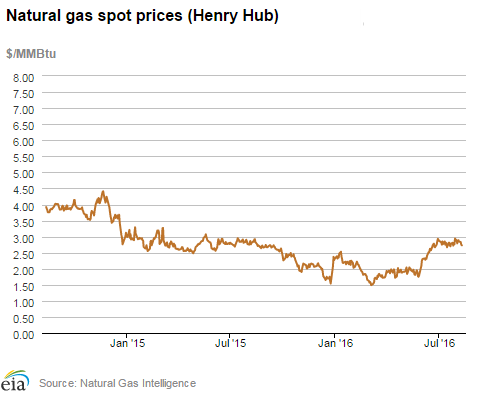
| Spot Prices ($/MMBtu) | Thu, 04-Aug |
Fri, 05-Aug |
Mon, 08-Aug |
Tue, 09-Aug |
Wed, 10-Aug |
|---|---|---|---|---|---|
| Henry Hub |
2.89 |
2.85 |
2.83 |
2.75 |
2.73 |
| New York |
1.55 |
1.53 |
1.94 |
2.12 |
2.44 |
| Chicago |
2.84 |
2.76 |
2.74 |
2.72 |
2.69 |
| Cal. Comp. Avg.* |
2.95 |
2.87 |
2.92 |
2.85 |
2.81 |
| Futures ($/MMBtu) | |||||
| September contract |
2.873 |
2.876 |
2.771 |
2.733 |
2.839 |
| October contract |
2.877 |
2.809 |
2.779 |
2.659 |
2.616 |
| *Avg. of NGI's reported prices for: Malin, PG&E Citygate, and Southern California Border Avg. | |||||
| Source: NGI's Daily Gas Price Index | |||||
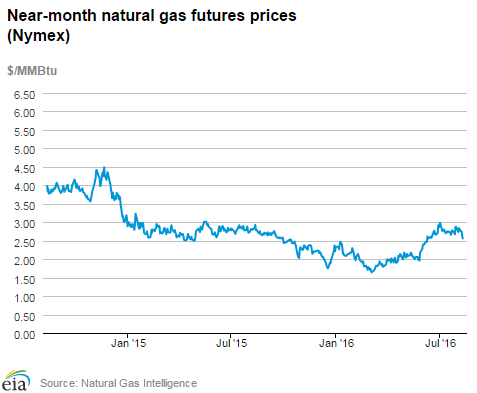
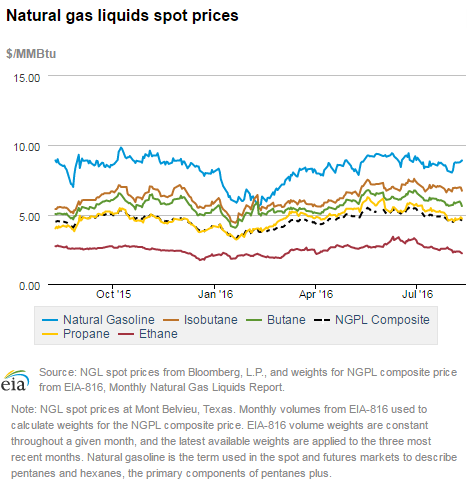
| U.S. natural gas supply - Gas Week: (8/4/16 - 8/10/16) | |||
|---|---|---|---|
Average daily values (Bcf/d): |
|||
this week |
last week |
last year |
|
| Marketed production | 81.7
|
81.6
|
82.0
|
| Dry production | 73.5
|
73.5
|
73.6
|
| Net Canada imports | 6.8
|
7.2
|
5.3
|
| LNG pipeline deliveries | 0.2
|
0.2
|
0.2
|
| Total supply | 80.5
|
80.9
|
79.2
|
|
Source: OPIS PointLogic Energy, an IHS Company | |||
| U.S. natural gas consumption - Gas week: Gas Week: (8/4/16 - 8/10/16) | |||
|---|---|---|---|
Average daily values (Bcf/d): |
|||
this week |
last week |
last year |
|
| U.S. consumption | 63.2
|
64.0
|
61.5
|
| Power | 36.5
|
36.8
|
34.0
|
| Industrial | 19.4
|
19.5
|
19.4
|
| Residential/commercial | 7.2
|
7.7
|
8.1
|
| Mexico exports | 3.7
|
3.8
|
3.3
|
| Pipeline fuel use/losses | 6.8
|
6.9
|
6.6
|
| LNG pipeline receipts | 0.9
|
0.9
|
0.0
|
| Total demand | 74.5
|
75.5
|
71.4
|
|
Source: OPIS PointLogic Energy, an IHS Company | |||
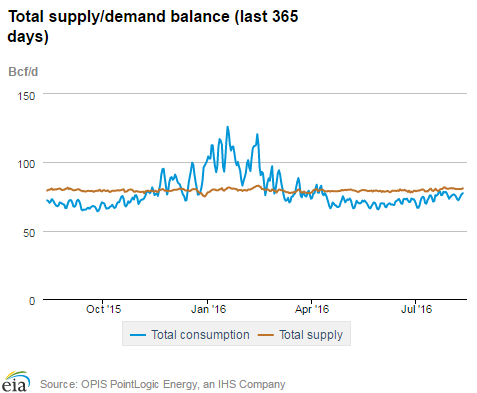
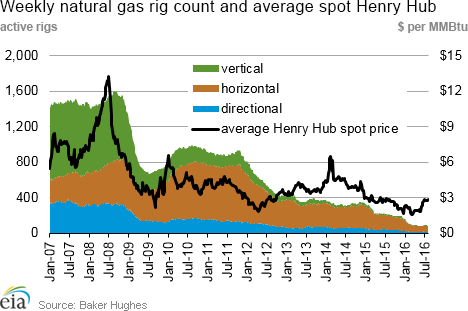
| Rigs | |||
|---|---|---|---|
Fri, August 05, 2016 |
Change from |
||
last week |
last year |
||
| Oil rigs | 381 |
1.9% |
-43.1% |
| Natural gas rigs | 81 |
-5.8% |
-62.0% |
| Miscellaneous | 2 |
-33.3% |
100.0% |
| Rig numbers by type | |||
|---|---|---|---|
Fri, August 05, 2016 |
Change from |
||
last week |
last year |
||
| Vertical | 58 |
-4.9% |
-55.0% |
| Horizontal | 362 |
2.3% |
-46.1% |
| Directional | 44 |
-8.3% |
-47.0% |
| Source: Baker Hughes Inc. | |||
| Working gas in underground storage | ||||
|---|---|---|---|---|
Stocks billion cubic feet (Bcf) |
||||
| Region | 2016-08-05 |
2016-07-29 |
change |
|
| East | 746 |
729 |
17 |
|
| Midwest | 845 |
825 |
20 |
|
| Mountain | 215 |
213 |
2 |
|
| Pacific | 314 |
314 |
0 |
|
| South Central | 1,197 |
1,207 |
-10 |
|
| Total | 3,317 |
3,288 |
29 |
|
| Source: U.S. Energy Information Administration | ||||
| Working gas in underground storage | |||||
|---|---|---|---|---|---|
Historical comparisons |
|||||
Year ago (8/5/15) |
5-year average (2011-2015) |
||||
| Region | Stocks (Bcf) |
% change |
Stocks (Bcf) |
% change |
|
| East | 674 |
10.7 |
688 |
8.4 |
|
| Midwest | 704 |
20.0 |
730 |
15.8 |
|
| Mountain | 175 |
22.9 |
166 |
29.5 |
|
| Pacific | 343 |
-8.5 |
326 |
-3.7 |
|
| South Central | 1,059 |
13.0 |
968 |
23.7 |
|
| Total | 2,956 |
12.2 |
2,877 |
15.3 |
|
| Source: U.S. Energy Information Administration | |||||
| Temperature -- heating & cooling degree days (week ending Jul 28) | ||||||||
|---|---|---|---|---|---|---|---|---|
HDD deviation from: |
CDD deviation from: |
|||||||
| Region | HDD Current |
normal |
last year |
CDD Current |
normal |
last year |
||
| New England | 0
|
-2
|
0
|
54
|
10
|
-6
|
||
| Middle Atlantic | 0
|
-3
|
0
|
64
|
5
|
-4
|
||
| E N Central | 0
|
-4
|
-1
|
71
|
15
|
20
|
||
| W N Central | 0
|
-2
|
-1
|
71
|
1
|
9
|
||
| South Atlantic | 0
|
0
|
0
|
114
|
17
|
7
|
||
| E S Central | 0
|
0
|
0
|
108
|
14
|
8
|
||
| W S Central | 0
|
0
|
0
|
139
|
13
|
4
|
||
| Mountain | 0
|
-2
|
0
|
91
|
14
|
8
|
||
| Pacific | 0
|
-2
|
0
|
72
|
25
|
2
|
||
| United States | 0
|
-2
|
0
|
88
|
14
|
6
|
||
|
Note: HDD = heating degree-day; CDD = cooling degree-day Source: National Oceanic and Atmospheric Administration | ||||||||
Average temperature (°F)
7-Day Mean ending Aug 04, 2016
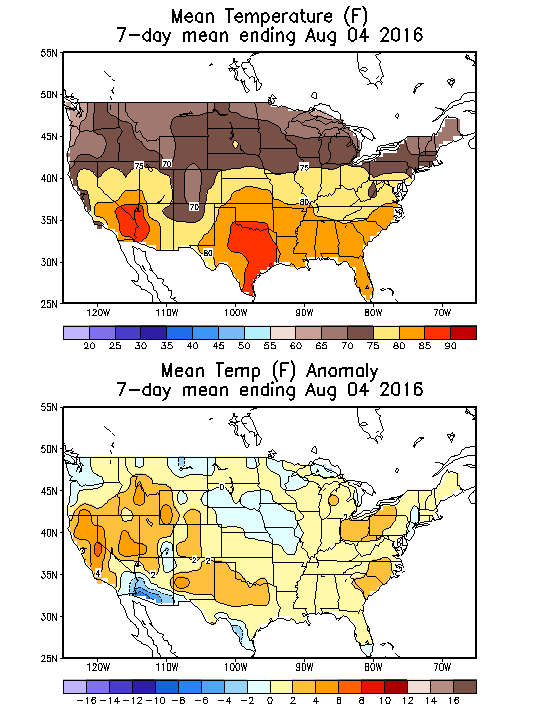
Source: NOAA/National Weather Service
Deviation between average and normal (°F)
7-Day Mean ending Aug 04, 2016

Source: NOAA/National Weather Service

